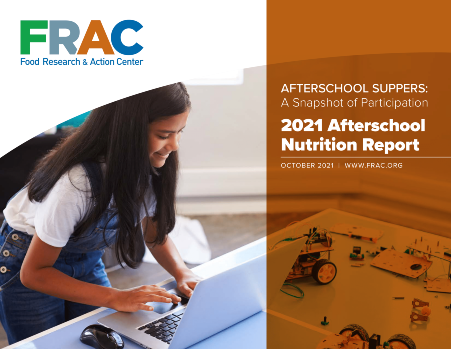A significant number of children missed out on nutritious suppers and snacks offered by the Afterschool Nutrition Programs, according to FRAC’s latest report, Afterschool Suppers: A Snapshot of Participation – October 2021 and October 2022.
Key Findings
-
- Over 1.15 million children received an afterschool supper on an average school day in October 2022.
- Participation in afterschool suppers decreased by 339,360 children, or 23 percent, in October 2022 when compared to October 2021.
- Participation in afterschool suppers remained relatively steady during the pandemic, serving 1.42 million children in October 2019, 1.45 million in October 2020, and 1.49 in October 2021.
- The Afterschool Snack Programs served nearly 1.19 million children on an average weekday in October 2022.


What Are the Afterschool Nutrition Programs?
The Afterschool Nutrition Programs play a critical role in helping to reduce hunger and support high-quality enrichment programs by providing healthy meals and snacks to children to ensure they are fed after school, on weekends, and during school holidays.
Afterschool programs have always been a critical access point for the nutritious foods that children need to grow and learn, helping mitigate the risk of learning and social emotional learning delays.
Afterschool meal providers have done amazing work during the previous two years amid adversity, changing their meal service operations to offer the suppers and snacks that families depend on and finding new ways to feed children.

Did you know?
The Afterschool Snack Programs began in 1998, and suppers became available nationwide in 2010 through the Healthy Hunger-Free Kids Act.
Afterschool Meals Participation Drops in 2022
During the pandemic, participation in afterschool suppers remained relatively stable, with participation slightly increasing in October 2020 and 2021. In October 2022, participation dropped for the first time since the program became available nationwide.
2022 marked the end of the pandemic waivers that addressed the operational challenges created by the public health emergency and allowed all communities to offer afterschool suppers. 5,000 fewer afterschool sites served suppers and/or snacks.
Many afterschool programs and meal sponsors continued to struggle with staffing shortages and increased food prices. Many afterschool programs have either closed or had to limit capacity during the pandemic and have not been able to fully recover.
Prior to the pandemic, a growing number of students were participating in afterschool meals each year. This increase in participation was plateauing even before the pandemic, highlighting the need to redouble efforts to increase participation.
Afterschool Resources

Afterschool Suppers: A Snapshot of Participation – October 2021 and October 2022
Read the report
Afterschool Report, 2021
Read our last report on afterschool meals and snacks
Communications Toolkit
Spread the word!
Federal Policy Recommendations
- Streamline the Afterschool Meal Program and Summer Food Service ProgramAllowing sponsors to operate one program year-round through the Summer Food Service Program would eliminate duplicative and burdensome paperwork while supporting sponsors’ efforts to serve more children in their community.
- Allow School Food Authorities to Serve Suppers Through the National School Lunch ProgramCongress should streamline the Afterschool Nutrition Programs to allow schools to provide up to a meal and a snack any day during the regular school year through the National School Lunch Program.
- Lower the Area Eligibility ThresholdLowering the eligibility threshold would improve access to suppers in every state.
State and Local Policy and Program Opportunities
- Mandate ParticipationMany states have made strides toward mandating participation in the School Breakfast Program and Summer Food Service Program in order to ensure that schools in low-income areas provide meals to eligible children. This option has started to pick up momentum on the afterschool nutrition front, with Virginia and Maine passing legislation requiring participation by schools operating afterschool programs.
- Allocate FundingA handful of states allocate funding to support school meals and summer food, including to supplement the federal reimbursement or for start-up costs. States that provide funding to support Child Nutrition Programs should consider including funding for afterschool suppers and snacks.
- Recruit School DistrictsSchool nutrition departments have the capacity and experience to operate Child Nutrition Programs successfully. School buildings often offer formal afterschool programs and informal activities and clubs that meet the requirement to offer an educational or enrichment activity. To expand the number of school nutrition departments participating, state agencies and advocates should conduct outreach to eligible schools, identify barriers to participation, and assist schools in overcoming those barriers.
- Serve Suppers Instead of (Or In Addition to) SnacksOne of the simplest strategies to reduce student hunger and improve nutrition is for afterschool programs to provide supper. If the program extends long enough, both supper and a snack could be offered. By not providing supper, sponsors and sites miss out on significantly higher federal reimbursements that make the afterschool nutrition program more financially viable.
- Improve Meal Quality and AppealAll suppers and snacks provided through the Afterschool Nutrition Programs must meet federal nutrition standards. Sponsors can further improve the meals they serve by incorporating fresh, seasonal food with Farm to Afterschool.
- Reduce BarriersFor example, long travel distances may make it challenging for some children to stay after school, even when programs are offered. To alleviate this barrier, schools can work to adjust bus schedules to allow for meal service and an enrichment activity before buses leave. Schools also can consider serving meals immediately after the bell rings in the classroom, alongside homework help.

